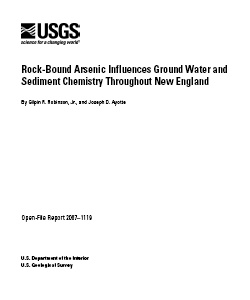Open-File Report 2007-1119

PDF (696KB, 18 pages)
Abstract — The information in this report was presented at the Northeastern Region Geological Society of America meeting held March 11-14, 2007, in Durham, New Hampshire. In the New England crystalline bedrock aquifer, concentrations of arsenic that exceed the drinking water standard of 10 µg/L occur most frequently in ground water from wells sited in specific metamorphic and igneous rock units. Geochemical investigations indicate that these geologic units typically have moderately elevated whole-rock concentrations of arsenic compared to other rocks in the region. The distribution of ground water wells with As > 5 µg/L has a strong spatial correlation with specific bedrock units where average whole-rock concentrations of arsenic exceed 1.1 mg/kg and where geologic and geochemical factors produce high pH ground water. Arsenic concentrations in stream sediments collected from small drainages reflect the regional distribution of this natural arsenic source and have a strong correlation with both rock chemistry and the distribution of bedrock units with elevated arsenic chemistry. The distribution of ground water wells with As > 5 µg/L has a strong spatial correlation with the distribution of stream sediments where concentrations of arsenic exceed 6 mg/kg. Stream sediment chemistry also has a weak correlation with the distribution of agricultural lands where arsenical pesticides were used on apple, blueberry, and potato crops. Elevated arsenic concentrations in bedrock wells, however, do not correlate with agricultural areas where arsenical pesticides were used. These results indicate that both stream sediment chemistry and the solubility and mobility of arsenic in ground water in bedrock are influenced by host-rock arsenic concentrations. Stream sediment chemistry and the distribution of geologic units have been found to be useful parameters to predict the areas of greatest concern for elevated arsenic in ground water and to estimate the likely levels of human exposure to elevated arsenic in drinking water in New England. However, the extreme local variability of arsenic concentrations in ground water from these rock sources indicate that arsenic concentrations in ground water are affected by other factors in addition to arsenic concentrations in rock.
For more information please contact the author.
This document is available online only in Portable Document Format (PDF); the latest version of Adobe Acrobat Reader or similar software is required to view it. Download the latest version of Acrobat Reader, free of charge or go to access.adobe.com for free tools that allow visually impaired users to read PDF files.